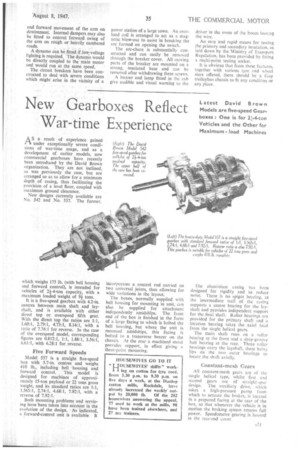New Gearboxes Reflect War-time Experience
Page 33

If you've noticed an error in this article please click here to report it so we can fix it.
Latest David Brown Models are five-speed Gearboxes : One is for 2-4-tort Vehicles and the Other for Maximum load Machines AS a result of experience gained under exceptionally severe conditions of war-time usage, and as a development of earlier models, new commercial gearboxes have recently been introduced by the David Brown organization. They are not inclined, as was previously the case, but are arranged so as to allow for a minimum depth of casing, thus facilitating the provision of a level floor, coupled with maximum ground clearance.
New designs currently available are No. 542 and No. 557. The former.
which weighs 175 lb. (with bell housing and forward control), is intended for vehicles of 2#-4-ton capacity, with a maximum loaded weight of 91 tons.
It is a five-speed gearbox with 4.2-in. centres between main shaft and layshaft, and is available with either direct top or overspeed fifth gear. With the direct top the ratios are 1:1, 1.60:1, 2.79:1, 4.73:1, 8.14:1, with a ratio of 7.76:1 for reverse. In the case of the overspeed model, corresponding figures are 0.812:1, 1:1, 1.88:1,3.56:1, 6.61:1, with 6.28:1 for.reverse.
Five Forward Speeds
Model 557 is a straight five-speed box with 5.7-in, centres and weighs 410 lb., including bell housing and forward control. This model is designed for machines of approximately 15-ton payload or 22 tons gross weight, and its standard ratios are 1:1, 1.565:1, 2.74:1, 4.681, 7.92:1, with a reverse of 7.92:1.
Both mounting problems and servicing have been taken into account in the evolution of the design. As indicated, a forward-control unit is available, It
incorporates a control rod carried on two universal joints, thus allowing for wide variations in the layout.
The boxes, normally supplied with bell housing for mounting in unit, can also be supplied for attachment independently amidships. The front end of the box is finished in the form of a large facing to which is bolted the bell housing, but where the unit is mounted amidships, this facing is bolted to a transverse bearer on the chassis. At the rear a machined snout provides support, in effect giving a three-point mounting. The aluminium casing has been designed for rigidity and to reduce noise. There is no spigot bearing, as the intermediate wall of the casing supports a centre bearing for the layshaft and provides independent support for The final shaft. Roller bearings are provided for the primary shaft and a location bearing takes the axial load from the single helical gears.
The main shaft runs on a
bearing at at the front and a deep-groove ball bearing at the rear. Three roller bearings carry the layshaft, there being lips On the two outer bearings to locate the shaft axially.
Constant-mesh Gears All constant-mesh gears ate of the single helical type, whilst first and second gears are of straight-spur design. The auxiliary drive, which takes a high-pressure pump from which in actuate the brakes, is located in a prepared facing at the rear of the box, so that whenever the vehicle is in motion the braking system returns full power. Speedometer gearing is housed in the rear-end cover.












































































